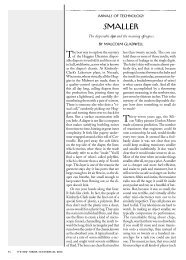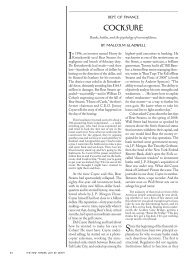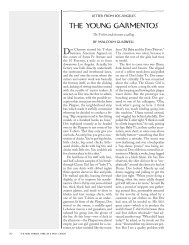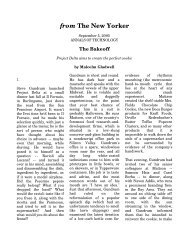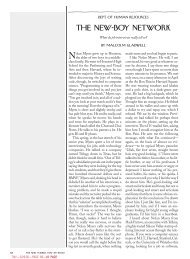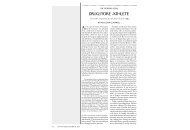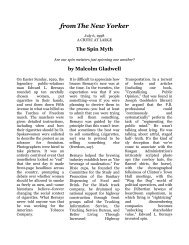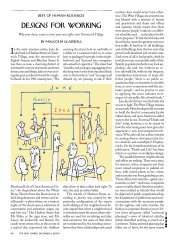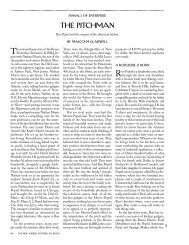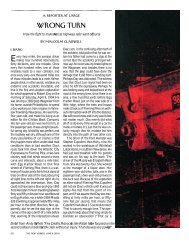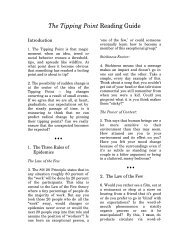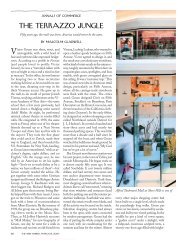iN THE AiR - Malcolm Gladwell
iN THE AiR - Malcolm Gladwell
iN THE AiR - Malcolm Gladwell
You also want an ePaper? Increase the reach of your titles
YUMPU automatically turns print PDFs into web optimized ePapers that Google loves.
eighteen T. rex specimens. From 1999<br />
until now, we’ve found nine more.”<br />
Myhrvold has the kind of laugh that<br />
scatters pigeons. “We have dominant<br />
T. rex market share.”<br />
In 1874, Alexander Graham Bell spent<br />
the summer with his parents in Brantford,<br />
Ontario. He was twenty-seven years<br />
old, and employed as a speech therapist<br />
in Boston. But his real interest was solving<br />
the puzzle of what he then called the<br />
“harmonic telegraph.” In Boston, he had<br />
tinkered obsessively with tuning forks<br />
and electromagnetic coils, often staying<br />
up all night when he was in the grip of an<br />
idea. When he went to Brantford, he<br />
brought with him an actual human ear,<br />
taken from a cadaver and preserved, to<br />
which he attached a pen, so that he could<br />
record the vibration of the ear’s bones<br />
when he spoke into it.<br />
One day, Bell went for a walk on a<br />
bluff overlooking the Grand River, near<br />
his parents’ house. In a recent biography<br />
of Bell, “Reluctant Genius,” Charlotte<br />
Gray writes:<br />
A large tree had blown down here, creating<br />
a natural and completely private belvedere,<br />
which [he] had dubbed his “dreaming<br />
place.” Slouched on a wicker chair, his hands<br />
in his pockets, he stared unseeing at the swiftly<br />
flowing river below him. Far from the bustle<br />
of Boston and the pressure of competition<br />
from other eager inventors, he mulled over<br />
everything he had discovered about sound.<br />
In that moment, Bell knew the answer<br />
to the puzzle of the harmonic telegraph.<br />
Electric currents could convey<br />
sound along a wire if they undulated in accordance<br />
with the sound waves. Back in<br />
Boston, he hired a research assistant,<br />
Thomas Watson. He turned his attic into<br />
a laboratory, and redoubled his efforts.<br />
Then, on March 10, 1876, he set up one<br />
end of his crude prototype in his bedroom,<br />
and had Watson take the other end<br />
to the room next door. Bell, always prone<br />
to clumsiness, spilled acid on his clothes.<br />
“Mr. Watson, come here,” he cried out.<br />
Watson came running—but only because<br />
he had heard Bell on the receiver, plain as<br />
day. The telephone was born.<br />
In 1999, when Nathan Myhrvold left<br />
Microsoft and struck out on his own, he<br />
set himself an unusual goal. He wanted<br />
to see whether the kind of insight that<br />
leads to invention could be engineered.<br />
He formed a company called Intellectual<br />
Ventures. He raised hundreds of millions<br />
of dollars. He hired the smartest people<br />
he knew. It was not a venture-capital<br />
firm. Venture capitalists fund insights—<br />
that is, they let the magical process that<br />
generates new ideas take its course, and<br />
then they jump in. Myhrvold wanted to<br />
make insights—to come up with ideas,<br />
patent them, and then license them to<br />
interested companies. He thought that if<br />
he brought lots of very clever people together<br />
he could reconstruct that moment<br />
by the Grand River.<br />
One rainy day last November, Myhrvold<br />
held an “invention session,” as he<br />
calls such meetings, on the technology of<br />
self-assembly. What if it was possible to<br />
break a complex piece of machinery into<br />
a thousand pieces and then, at some predetermined<br />
moment, have the machine<br />
put itself back together again? That had<br />
to be useful. But for what?<br />
The meeting, like many of Myhrvold’s<br />
sessions, was held in a conference<br />
room in the Intellectual Ventures laboratory,<br />
a big warehouse in an industrial<br />
park across Lake Washington from Seattle:<br />
plasma TV screens on the walls, a<br />
long table furnished with bottles of Diet<br />
Pepsi and big bowls of cashews.<br />
Chairing the meeting was Casey<br />
Tegreene, an electrical engineer with a<br />
law degree, who is the chief patent counsel<br />
for I.V. He stood at one end of the<br />
table. Myhrvold was at the opposite end.<br />
Next to him was Edward Jung, whom<br />
Myhrvold met at Microsoft. Jung is lean<br />
and sleek, with closely cropped fine black<br />
hair. Once, he spent twenty-two days<br />
walking across Texas with nothing but a<br />
bedroll, a flashlight, and a rifle, from Big<br />
Bend, in the west, to Houston, where he<br />
was going to deliver a paper at a biology<br />
conference. On the other side of the table<br />
from Jung was Lowell Wood, an imposing<br />
man with graying red hair and an<br />
enormous head. Three or four pens<br />
were crammed into his shirt pocket. The<br />
screen saver on his laptop was a picture of<br />
Stonehenge.<br />
“You know how musicians will say,<br />
‘My teacher was So-and-So, and his<br />
teacher was So-and-So,’ right back to<br />
Beethoven?” Myhrvold says. “So Lowell<br />
was the great protégé of Edward Teller.<br />
He was at Lawrence Livermore. He<br />
was the technical director of Star Wars.”<br />
Myhrvold and Wood have known each<br />
other since Myhrvold was a teen-ager<br />
and Wood interviewed him for a gradu-<br />
<strong>THE</strong> NEW YORKER, MAY 12, 2008 51



